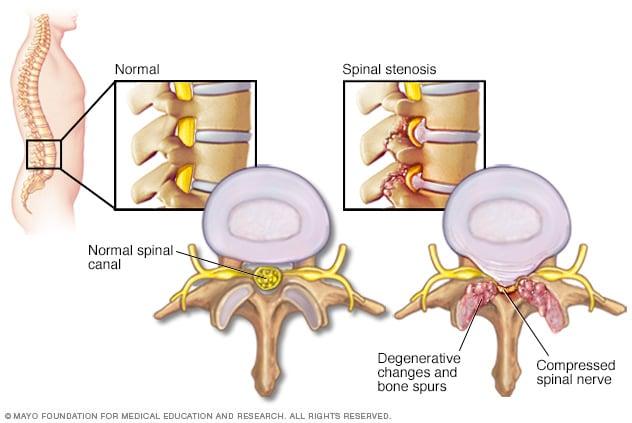Have you ever had back pain radiating down into your leg? Was this pain also accompanied by pins and needles sensation or numbness along the buttocks, thighs or legs? If you did experience these symptoms or are still currently experiencing these symptoms, you may have either lumbar stenosis or a herniated disc.
What is a herniated disc?

A herniated disc is also commonly known as a ‘slipped disc’ or a ‘bulging disc’. In our spine, the disc is a layer of cartilage-like tissue that acts as a shock absorber to dampen forces sent through our spine. It also provides flexibility to the spine during our day-to-day movements. The disc contains a soft, gel-like centre (nucleus pulposus) and a firmer outer layer (annulus). Occasionally, the contents of the nucleus pulposus may leak out of the outer annulus layer and may irritate or compress the nearby spinal nerves, causing pain to shoot down the leg.
The term “slipped disc” often gives people the false impression that their discs have slipped out of the spine. An intervertebral disc is firmly anchored into the vertebral bones above and below by vertebral end plates and is surrounded by strong ligaments. Hence, there is no way a disc can slip. The disc may bulge a little but it is still stable in its position. The correct term should be “herniation”, “disc bulge”, or “disc prolapse”.
There are a few contributing factors to a herniated disc, such as:
- Ageing
- Excessive weight
- Being sedentary
- Repetitive movements of the spine
- Sudden strain from an injury or improper lifting or twisting
What are the signs and symptoms of a herniated disc?
Herniated disc usually affects one side of the body but can also affect both sides depending on where the herniated disc is situated. Symptoms may vary depending on whether the disc is irritating or impinging on a nerve.
- Leg pain. Besides pain in your lower back, you will typically feel pain radiating down to your buttocks, thigh or leg. This pain is often described to be sharp and electric shock-like.
- Numbness or tingling. Pressure from the disc on the spinal nerves can also cause numbness, burning or tingling sensations from the back down to the buttocks, thigh or leg.
- Weakness. Muscles that are supplied by the compressed nerve tend to gradually weaken. This may cause you to stumble when you walk.
What is lumbar stenosis?

Lumbar stenosis occurs when the spaces in the spine narrow and create pressure on the spinal cord or spinal nerves. Your spinal cord is a bundle of nerves that comes out of the base of the brain and runs through a tunnel (spinal canal) formed by your spinal vertebrae. The spinal nerves are nerves that branch out from the cord. Stenosis, which means narrowing, usually occurs over time and it may involve one or more areas of the spine.
The most common cause of lumbar stenosis is osteoarthritis and other age-related wear and tear that happens to your joints over time. Most people who suffer from spinal or lumbar stenosis are aged 50 or older. Besides osteoarthritis and age-related wear and tear, other conditions that can cause lumbar stenosis are:
- Scoliosis
- Spinal tumours
- Rheumatoid arthritis
- Certain bony diseases
- Congenital narrowing of the spinal column
- Fractures to the spine due to trauma or other medical conditions
What are the signs and symptoms of lumbar stenosis?
Similar to a herniated disc, lumbar stenosis can lead to back pain radiating to the leg, numbness or tingling down the leg, or weakness of your lower body. In addition to the above, lumbar stenosis that is affecting the spinal cord can also lead to more serious symptoms. If you have any of these symptoms, you may need to seek immediate medical attention:
- Loss of bowel or bladder control
- Loss of sensation in your bowel and/ or bladder region
- Severe, progressive problems in the lower extremities, including loss of strength in both legs, loss of or altered sensation in both legs
Medical Investigations
To diagnose lumbar stenosis or lumbar disc herniation, your healthcare provider will ask you questions about your symptoms and do a complete physical examination. During the physical examination your healthcare provider assesses your stability, sensation, strength, reflexes, alignment and motion. You may be asked to stand, sit, walk on your heels and toes, bend forward, backward and to the sides, and lift your legs while lying down.
Tests that can help with a diagnosis:
- X-Ray of the lower back to check for osteoarthritis, bone spurs
- Computed tomography (CT) scan, which takes more detailed images
- Magnetic resonance imaging (MRI) scan of the spine
- EMG (electromyogram) to check the nerves going to your legs
- X-Rays of the hips or knees
- Blood tests, as well as tests to check the circulation in your legs and to rule out other diseases with similar symptoms
Treatment
If you have disc herniation or lumbar stenosis, the initial treatment is usually conservative and non-surgical. Treatment usually includes physiotherapy and medication. A doctor may recommend surgery if conservative treatment does not help in reducing your symptoms.
- Physical therapy. This may include exercises to strengthen your back, abdominal, and leg muscles. Learning how to do activities safely, using braces to support your back, stretching, and massage may also be helpful.
- Medicines. Non-steroidal, anti-inflammatory medicines that relieve pain and swelling, and steroid injections that reduce swelling.
- Surgery. This includes removing bone spurs and widening the space between your lumbar vertebrae.
Exercises
These are some exercises that can help to relieve your pain. For more information or details of these exercises, please consult your physiotherapist.
Lumbar rotation


- Lying on your back with your arms in a T-position and knees bent towards the ceiling.
- Slowly roll both your legs from side to side without touching the floor.
- Repeat 10 times to each side.
Sit-to-stand


- Sit in a chair with your back away from the back support.
- Shift your weight forwards and stand up by straightening your hips and knees. Only use your arms, if needed. Sit back down controlling the movement.
- Repeat 3 sets of 10 times.
Gluteus Stretch


- Sit up straight with your ankle on top of the other knee.
- Bend your trunk forward and press the knee down until you feel a stretch in the hip muscles of the bent leg. (Note: Bend from your hips instead of from your trunk)
- Hold for 20 seconds, repeat 5 times.
At Physio & Sole Clinic, we strive to provide recovery for our patients in the quickest and safest manner through physiotherapy treatments for them so that they are able to resume back to their lifestyle, injured-free. Speak with our physiotherapists through our Ask a Physio whatsapp platform to get your enquiries answered or book an appointment at any one of our clinics islandwide.






